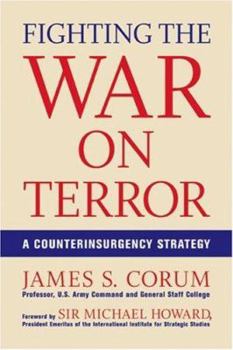Fighting the War on Terror: A Counterinsurgency Strategy
Select Format
Select Condition 
Book Overview
The threat of terrorism and insurgency is one that dominates the world, and how to fight and defeat these 'non-state' enemies is the most urgent question confronted by the military and politicians.... This description may be from another edition of this product.
Format:Hardcover
Language:English
ISBN:0760328684
ISBN13:9780760328682
Release Date:January 2007
Publisher:Zenith Press
Length:304 Pages
Weight:1.25 lbs.
Dimensions:1.1" x 6.3" x 9.3"
Customer Reviews
3 ratings
A Great Macro and Micro look at the war
Published by Thriftbooks.com User , 17 years ago
This is a great book for those who want to understand things beyond the politicians speeches. The book gives the readers both an understanding of they way things are and a few ideas of where the nation needs to go. His historical examples provide the reader insight to the current situation overseas. The war isn't new but neither is it hopeless. The author shows that the war needs a broad approach beyond just a military approach. The style is easy to understand and fast flowing. He also attacks the war on a broad front. He digs into such subjects as PR and training of host nation Armies. I think most will enjoy the book. The book does focus only on the strategic side of the war. If you want war stories of the soldiers you will have to get other books.
A key acquisition for both military libraries and college-level holdings
Published by Thriftbooks.com User , 17 years ago
Dr. Corum is one of the Army's top experts on counterinsurgency warfare: it's this background which packs FIGHTING THE WAR ON TERROR with lessons which need to be learned from the experiences of all sides. His book advocates spending more on training and lesson weapons - and using the media to counter extremist propaganda. Chapters analyze lessons learned from experience and consider how they can be applied to future conflicts, making this a key acquisition for both military libraries and college-level holdings specializing in social issues.
Necessary Reading on How To Fight Insurgencies
Published by Thriftbooks.com User , 17 years ago
This relatively short, but lucid and concise, book gives a good overview of the terrorist/insurgent threat America faces currently, and prescribes general force structures and strategies on how to combat this threat. It is well organized, leading the reader through a synopsis of the state of the world with a focus on Al-Qaeda, Afghanistan and Iraq, then through the development of the modern American military, a short history of modern counterinsurgency and the lessons learned, and how to generally fight the insurgency in Iraq. There is clearly a very high level of thought and research that has gone into the book, and it is written in an analytical manner that adds a considerable weight of believability to its conclusions. The general theme of the book is that America's military is still, even six years after 9/11 and four since the fall of Baghdad, not geared towards fighting insurgencies and occupying / developing third world nations racked by corruption and poverty, and stained by dictatorial rule that become the hotbeds for Islamic terrorism. It is far too focused on fighting conventional state on state wars in as quick as possible a manner and with as few people as possible relying heavily on technology; a reliance that stemmed from the necessities of the Cold War but which has not been re-evaluated in the face of new threats. Technology however will not win the war in Iraq or the broader war in terror contends the author. Drawing on the history of the successes and failures of counter-insurgency efforts in Malaysia, the Philippines, El Salvador, Algeria and Vietnam Mr. Corum draws some lessons about how to fight a war such as exists in Iraq today. He concludes we have too few troops there, and generally suggests a much larger troop presence in order to fully ensure stability first. Subsequently civil affairs and engineering troops can re-develop the infrastructure of the country -including oil infrastructure, schools, hospitals, roads, etc.-, effectively train local forces with long term training, and establish the legitimacy of the government with propaganda campaigns and political reforms. America has continuously broke itself on dreams of small forces and quick fixes being able to change the situation on the ground in Iraq for good, when insurgencies are generally long term and personnel heavy operations. He also details many of the general tactics troops involved in counter-insurgencies should employ, including employing local forces when available, using restraint to avoid civilian deaths in most cases, and how to interrogate prisoners. There are a few places where the book leaves what feel like loose ends though. First, although the author makes a solid case that the war in Iraq is an integral part of the war on Terror, by the end of the book it seems more like a book on how specifically to fight the Iraq campaign and not the overall war on terror. (Although his recommendations on the changes to the US force structure






